#1913 Dublin Lockout
Explore tagged Tumblr posts
Text
#OTD in 1911 – 3,000 women at Jacob's factory led by young Rosie Hackett, withdrew their labour in pursuit of a pay claim.
Rosie Hackett helped to galvanise and organise more than 3,000 women working in the factory. They withdrew their labour and the women were successful. They received better working conditions and an increase in pay. Rosie was just 18 years old at the time. When the Irish Transport and General Workers Union was founded in 1909, Rosie joined. Two weeks after the famous Jacobs strike, Rosie cofounded…

View On WordPress
#1913 Dublin Lockout#1916 Easter Rising#Constance Markievicz#Delia Larkin#Helena Maloney#Irish Citizen Army#Irish Transport and General Workers Union#Irish Women Workers Union#ITGWU#IWWU#Jacob&039;s Biscuit Factory#James Connolly#Jim Larkin#Kilmainham Jail#Liberty Hall#Louie Bennett#Michael Mallon#Rosie Hackett#Trade Union
5 notes
·
View notes
Text
Recap of the Irish War of Independence
One cannot talk about or understand the Irish Civil War without understanding the Irish War of Independence. In fact, I’ve seen more and more historians argue that we can think of the Irish War of Independence and the Irish Civil War as one big civil war, since the Royal Irish Constabulary, the IRA’s main enemy before the Black and Tans arrived, were Irish themselves and IRA intimidated, harassed, and executed Irish people who they considered “informers and traitors.” Additionally, many of the hopes, dreams, and aspirations initiated by the women’s liberation moment of 1912, the Lockout of 1913, and Easter Rising were further refined by the Irish War of Independence, and contributed to the violent schism in Irish Society following the signing of the Anglo-Irish Treaty. These aspirations and goals would further be redefined by the Irish Civil War with participants of all sides feeling like they lost more than they gained from the entire affair.
Thus, why I feel it’s important to recap the major events of the Irish War of Independence
Leading Up to the Irish War of Independence
Ireland has always been a place of debate, uprisings, and desire for change, but in the early 1900s there were three movements that paved the way for the Irish War of Independence: the Suffragette Movement of 1912, the Gaelic Revival, the 1913 Lockout, the Home Rule Campaign and Easter Rising. I’ve discussed all four movements in great detail in the first season, but in summary, the Suffragette Movement, the Gaelic Revival, and the 1913 Lockout created an environment of mass organizing and brought together many activists and future revolutionaries. The Home Rule Campaign, combined with WWI, created the conditions for a violent uprising.
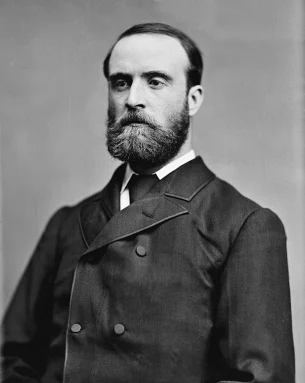
Charles Parnell
[Image description: A black and white photo of a white man with a high forehead and a thick, round beard. He is wearing a white button down and black tie and a grey double breast jacket.]
British Prime Minister Gladstone introduced the concept of Home Rule in 1880, with support from one of Ireland’s most famous statesmen: Charles Parnell. The entire purpose of Home Rule was to grant Ireland its own Parliament with seats available to both the Catholic majority and the Protestant minority and current power brokers). However, Parnell destroyed support for Home Rule by being involved in a messy and scandalous divorce and the Irish Republican Brotherhood (IRB), the precursor to the Irish Republican Army (IRA), scared the British government with their terrorist attacks. Home Role went through another failed iteration, but John Redmond was confident he would get the third iteration passed. This newest iteration was introduced to Parliament in 1914 and have created a bicameral Irish Parliament in Dublin, abolished Dublin Castle (the center of British power in Ireland), and continued to allow a portion of Irish MPs to sit in Parliament. It was supported by many nationalists in Ireland, barely tolerated by the Asquith Administration, and despised by the Unionists.
The Unionists believed they had a reason to worry. They had not forgotten the Protestants slaughtered during the 1798 Uprising nor the power they lost through the machinations of O’Connell and Parnell. Facing a massive change in their lives should Home Rule pass, the Unionists took a page out of the physical force book and created their own paramilitary organization: the Ulster Volunteers. The Asquith government knew of the Ulster Volunteers, their gun smuggling, and their drilling, but did nothing except delay Home Rule as long as possible.
Asquith’s delaying tactics and the creation of the Ulster Volunteers made Irish Nationalists nervous and they took matters into their own hand. Arthur Griffith, an Irish writer, politician, and the source of inspiration for many young rebels created the political party, Sinn Fein. Griffith argued for a dual monarchy approach, similar to the Austrian-Hungary model. He believed Ireland and England should be separate nations, united under a single monarchy. He also introduced the concept of parliamentary absenteeism i.e., Sinn Fein was a political party that would never sit in British Parliament, because the parliament was illegitimate.
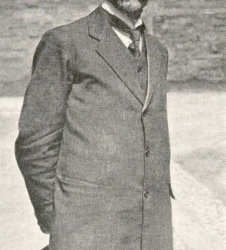
Eoin MacNeill
[Image description: A black and white picture of a tall man in a courtyard. He has a high forehead, wire frame glasses, and a shortly trimmed beard. He is standing with his hands behind his back holding a hat. He is wearing a white button down, a tie, a vest, and a suit jacket and grey pants.]
In response to the Ulster Volunteers, Eoin McNeill and Bulmer Hobson created the Irish Volunteers. Both men believed that the Irish wouldn’t stand a chance in an uprising against the British government and their best bet was to trust Redmond to pass Home Rule. The Irish Volunteers were created in order to defend their community from Unionist attacks. Things were tense in Ireland, but it seemed that parliamentary politics could save the day and the extremists would be pushed to the sidelines.
Then World War I began.
The British used the war to pass Home Rule but delay it taking affect for another three years. To add insult to injury, John Redmond encouraged young Irishmen to enlist in the British Army and fight for the Empire. McNeill and Hobson tried to convince its members to continue to trust Redmond, although they were angry that he was recruiting for the war. Yet, there was a handful of Irish Volunteers, who were also members of the resurrected IRB believed England’s difficulty, Irish opportunity.
They were Tom Clarke, Sean MacDiarmada, Padraig Pearse, Thomas MacDonagh, Eamonn Ceannt, and Joseph Plunkett. These men, plus James Connolly of the Irish Citizen Army, would sign the Proclamation of the Irish Republic and it would serve as their death warrant.
They knew they would not be able to win without arms and support, so, keeping their plans to themselves, they sent Roger Casement to Germany to present their plans for a German invasion that would coincide with an Irish rising. The Germans rejected this plan (maybe remembering what happened in 1798, when the French made a similar landing, weeks after a massive Irish uprising), but promised to send arms.
The Irish Volunteers were often seen drilling and practicing for some vague rebellion, so it wasn’t suspicious to the authorities or to MacNeil and Hobson to see units marching around. When Pearse issued orders for parade practice on April 23rd, Easter Sunday, MacNeil and Hobson took it at face value while those in the know, knew what it really meant. This surreal arrangement would not last for long and the committee’s secrecy nearly destroyed the very rising it was trying to inspire.
The first bit of trouble was Roger Casement’s arrest. The Germans were less than supportive of the uprising, and Casement boarded the ship Aud to return to Ireland to either stop or postpone the rising. However, when he arrived in Ireland on either April 21st or 22nd, he was pick up by British police and placed in jail.
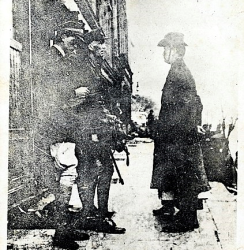
Pearse Surrenders
[Image description: A faded black and white photo of three men standing on a street in Dublin. There are two man on the left and they are wearing the khaki cap and uniform of the British army. On the right is a man wearing a wide brim hat and a long black jacket]
Then MacNeil and Hobson had their worst suspicions confirmed-Pearse and his comrades were secretly planning a rebellion without their support. MacNeill vowed to do everything (except going to the authorities) to prevent the Rising and sent out a counter-order, canceling the drills scheduled for Sunday. This counter-order took an already confused situation and turned it into a bewildering disaster. Units formed as ordered by Pearse and dispersed with great puzzlement and some anger and frustration. Pearse and his comrades met to discuss their next steps and decided the die had been cast. There was no other choice except to try again tomorrow, Monday, 24th, April 1916.
Easter Rising was concentrated in Dublin with a few units causing trouble on the city’s outskirts. The Irish rebels fought from Monday to Friday, surrendering Friday morning. The leaders of the rising were murdered, but many future IRA leaders such as Eamon DeValera, Michael Collins, Richard Mulcahy, Constance Markievicz, Liam Lynch, and others survived. They were sent to several different prisons, the most famous being Frongoch where Collins was held. The IRB turned it into a revolutionary academy and practiced their organizing and resistance skills while formalizing connections and relationships. When they were released starting in December 1916, they were ready to take those skills back to Ireland.
Creation of the IRA and the Dail
Their approach was two pronged: winning elections and rebuilding the Irish Volunteers/ Irish Republican Brotherhood.
When the prisoners were released, the Irish population went from hating them for launching a useless rebellion to cheering their return. The English helped flame the revolutionary spirit in Ireland by proclaiming Easter Rising a “Sinn Fein” rebellion and arresting many Sinn Fein members who had nothing to do with the Rising. This made it clear Sinn Fein was the revolutionary party while John Redmond’s party was out of touch.
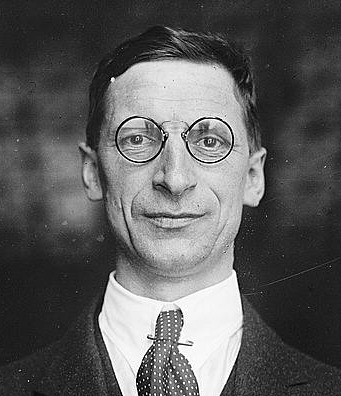
Eamon de Valera
[Image description: A black and white photo of a white man with a sharp nose and large, circular glasses. He has black hair and is wearing a white button down shirt, a polka dotted tie, and a grey suit.]
Sinn Fein ran several candidates such as Eamon DeValera, Michael Collins, and Thomas Ashe. Ashe would be arrested while campaigning and charged with sedition. While in jail, he went on hunger strike and was killed during a force feeding. Following an Irish tradition, Sinn Fein and the IRB turned Ashe’s funeral into a political lightning rod. They organized the funeral procession, the three-volley salute, and Collins spoke over Ashe’s grave: “There will be no oration. Nothing remains to be said, for the volley which has been fired is the only speech it is proper to make above the grave of a dead Fenian.”
On October 26th, 1917, Sinn Fein would hold their first national convention. During the convention, Eamon DeValera replaced Arthur Griffith as president and Sinn Fein dedicated itself to Irish independence with the promise that after independence was achieved the Irish people could elect its own form of government. However, there was still tension between those who believed in passive non-violence and the militant Sixteeners. 1917-1918 was spent building a bridge between parliamentary politics and militant politics of the 1920s, with Sinn Fein’s large young membership pushing it in a more militant direction.
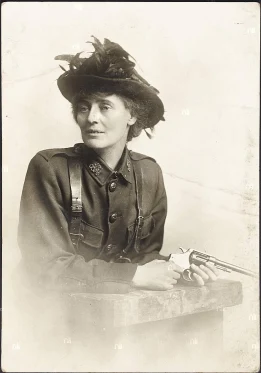
Constance Markievicz
[Image description: A sepia tone photo of a white woman looking to her right. She is leaning against a stool and holds a revolver. She wears a wide brim hat with black feathers and flowers. She has short hair. She is wear a military button down short and suspenders.]
Sinn Fein was also breaking social conventions, even though Cumann na mBan was still an auxiliary unit, Sinn Fein would allow four ladies on the Sinn Fein Executive and would run two women in the 1918 election-Constance Markievicz and Winifred Carney, with Markievicz becoming the first women to win a seat in parliament. Many of its supporters and campaigners were also women. In fact, many men would complain in 1917 and later that the women were more radical than the men. Cumann na mBan fully embraced the 1916 Proclamation and even had Hanna Sheehy-Skeffington deliver a message to President Wilson in 1918, asking him to recognize the Irish Republic. Cumann na mBan took the front line in the anti-recruitment campaign and the police boycott and the anti-conscription movement. Like the Volunteers, Cumann na mBan believed they were a military unit, although they never got arms for themselves and worked closely with Volunteer units and Sinn Fein clubs.
Irish Volunteers and IRB
While Sinn Fein was slowly rebuilding itself, the Irish Volunteers were also being resurrected from the ashes. It started with local initiatives led by men like Ernest Blythe, Eoin O’Duffy, and Sean Treacy. Units popped up in local communities, organized and armed by their local leaders and eventually contacting GHQ which consisted of men like Collins, Mulcahy, and Brugha. While local units were rebuilding themselves, Collins was using the IRB to form a strict corps of officers, a growing source of personal power as well as military power that men like Brugha and De Valera (who were IRB during Easter Rising, but renounced their membership after the rising failed) distrusted.
GHQ issued an order saying that units should only listen to orders coming from their own executive (in order to prevent the order-counter-order disaster that doomed Easter Rising) and swore the Volunteers would only be ordered into the field if commanders were confident of victory. No forlorn battles. Mulcahy, as Chief of Staff, worked hard to instill a military spirit and discipline into the Volunteers while understanding that their most effective unit at the moment was the company and local initiative. (The companies would expand into battalions and brigades as the war progressed, but the fighting and tactics would remain local and territorial) So, while trying to act like a regular army and expecting the Volunteers to respect their officers and GHQ, he also had to allow for local improvisation as well as trust the local executives to have control over their soldiers. It was a difficult balancing act he would struggle to maintain during the entire Anglo-Irish War and into the Irish Civil War and the formation of the Free Irish State.
The Irish Volunteers convention on October 26th, 1917, elected DeValera as president, Brugha as the chairman of the executive with Collins as director of organization and Mulcahy as director of training, Liam Lynch as Director of Communications, Staines, Director of Supply and Treasurer, O’Connor director of engineering.
All of this work could have been for nothing if the British hadn’t handed the IRA the greatest gift in the world: the 1918 conscription crisis.
Lightning Rod Issues
Food Shortage 1917-1918
Before conscription was the food shortages in the winter of 1917-1918. The shortage was created because of food being exported to Britain, invoking memories of the terrible famine. Sinn Fein could not stop all of the food being exported, but they did what they could to protest this newest version of starvation. For example, a member of Sinn Fein, Diarmund Lynch took thirty pigs meant to for exportation, killed them, and shared the food with hard hit families, earning him deportation to America, but becoming a local folk hero and increasing Sinn Fein’s prestige.
There were also agrarian tensions because grazers (those who used farmland for their cows to graze instead of growing crops) were given preference to available land so the Congested Districts Board could maximize profits. While this makes sense, it added to the great unease in the land, especially as the food shortage grew more acute.
The IPP grew out of the Land Wars of 1880s and Sinn Fein, ever aware of Irish history, decided it would be no different. It joined in the fight for land, arguing that all the ranch land should be broken up evenly. All over the country, Sinn Fein created commission to break up the land and figure out the pricing as well as organizing mass occupation of available land, but ranchers refused to acknowledge the prices Sinn Fein proposed.

1917 Electoral Victory March
[Image description: A black and white photo of several men and women marching together through a park with several tall green trees and a cobblestone wall. Leading the crowd are three men in long coats and wide brim hats playing bagpipes. Everyone else is wearing long coats, suit coats, or dresses and hats.]
The Irish Volunteers officially stayed out of the new land war, claiming it wasn’t military or political in nature, but local groups sometimes participated. This combined with Sinn Fein’s own land seizures could lead to painful confrontations with police and other anger Irish men, so it was a difficult job balancing non-violent and not starting a mass uprising.
Another tool Sinn Fein used was boycotting. Said to original in Ireland during the Land Wars and used to great affect by Charles Parnell, Sinn Fein boycotted the RIC. This was a serious threat to the British system, decreasing the pool of candidates it could recruit from for the RIC and training the people to view the RIC as “others,” the first step to making a population comfort with violent action.
Boycotting the RIC was an old idea, something Sinn Fein and the Irish Volunteers wanted to implement it as soon as they were released from prison. This became a strong tool of the Volunteers to ostracize those who were betraying the rebel cause by working for the British as well as prepare the citizens for a war mentality.
Conscription crisis
No one yet knew that World War I would be over by November 11th, 1918. British thought she was facing long years of further bitter sacrifices and they needed new blood. They looked at Ireland and its large set of unruly young men itching for a fight and introduced the Military Service bill, extending forced conscription to Ireland-giving the Volunteers a shot in the arm while also uniting the Irish political parties, for the first time ever.
The Sinn Fein, IPP, and the Catholic Church pledged to resist Britain’s efforts to conscript Irishmen. DeValera prepared a statement, meant for Woodrow Wilson, insisting that their resistance was a battle for self-determination and principles of civil liberty, similar to the American’s cause during America’s revolution. The Volunteers planned local actions as well, using the conscription crisis as a springboard for intensive recruiting and introducing the idea of militant resistance into the greater Irish consciousness. The boycott of the RIC increased tenfold during the anti-conscription movement, shocking the police and trapping them in their barracks in locations such as North Tipperary. Women were particularly effective implementers of the boycott. Eventually the boycott was expanded to include those who helped or associated with the police. The boycott didn’t force many police to resign, but it built a belligerent and hateful mindset against the police-allowing for later violence.
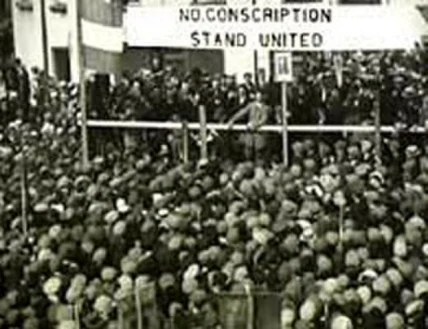
Anti-conscription Rally in Ballaghaderreen County
[Image description: A blur black and white photo of a large gathering of people. They are surrounding a wooden platform where as group of men stand. Above the platform there is a white banner that says: No conscription Stand United]
The Irish Volunteers were not as engaged with the conscription crisis as Sinn Fein, because they still didn’t have a doctrinal strategy in place. Instead, volunteers were told to avoid getting arrested and if the RIC tried to arrest them, to resist. The Volunteers held daily drills and parades and prepared for battle, should the order ever arrive. However, GHQ seemed more concerned with getting rifles and ammunition than ordering a massive uprising. Conscription allowed them to demand that the local area their units controlled give up their guns to the Irish Volunteers. Some Volunteers even bought rifles off RIC or local British soldiers. Lack of guns would be a problem that plagued the IRA through their war with the British. Conscription also saw a spike in people joining the Irish Volunteers. GHQ tried to manage this wave of volunteers by issuing orders regarding how men should be recruits and how they should be vouched for and accepted.
The Irish Volunteers allowed their own soldiers to elect their officers (how could this go wrong?) GHQ seemed to try and curb who could be elected like requiring that they be member of the IRB, but given the haphazard nature these units were created, but it was only somewhat successful, some units merging the Volunteers and IRB men seamlessly, while other companies were dominated by non-IRB men or vice versa.
They threatened mass slaughter should Britain try to enforce conscription and, apparently, there was a plan for Cathal Brugha to lead a group of men to assassin the British cabinet (relying on Collins and Mulcahy-who was now chief of staff-to recruit for this venture).
German Plot
The British back down on conscription in mid-May while also arresting 73 nationalist leaders from May 17-18 under the Defense of the Realm Act, including Eamon DeValera, Constance Markievicz, Arthur Griffith, and William Cosgrave. They claimed there was a German plot i.e., Sinn Fein was working with Germany-like the 1916 rebels did and the 1798 rebels with the French.
It quickly became clear how flimsy the excuse was, that there was scant information, and undermined the government’s credibility in Ireland. It successfully knocked Sinn Fein off its feet for a moment, especially since all nine of the twenty-one members of Sinn Fein’s Standing Committee were arrested, but the British failed to arrest some of the most dangerous rebels such as Collins, Brugha, Mulcahy, and Harry Boland. But in the long run, it boosted Sinn Fein’s cause and destroyed any chance IPP had of reclaiming the national narrative. As Constance Markievicz claimed, "sending you to jail is like pulling out all the loud stops on all the speeches you ever made…our arrests carry so much further than speeches.”
1918 Election
Sinn Fein had won a total of five elections between 1917 and 1918 (De Valera, Count Plunkett, Cosgrave, Patrick MacCartan, and Griffith) and lost two elections. 1918 was their first general election. The election was held on December 14th, 1918, and is considered one of the most important moments in modern Ireland’s history. It was the first election after the end of the First World War and, because of the Representation of the People Act, women over the age of 30 and working-class men over the age of 21 could vote, tripling the Irish electorate from 700,000 in 1910 to 1.93 million in 1918.
The IPP won only 6 seats, the Unionists took 26 seats, and Sinn Fein won 73 seats.
The Sinn Fein victory can be explained in three different ways:
The new electoral: women and working-class men: people who had been hardest hit by the war and the rising and the conscription crisis, as well as the good shortage in 1917.Not only was Sinn Fein and Irish Volunteers campaigning, but Cumann na mBan campaigned hard as well, possible driving people into the arms of Sinn Fein since Sinn Fein stood for a republic which was against everything as it currently was. iSinn Fein’s rivals: the IPP and Labour had been broken by WWI and needed to rebuild themselves and their reputations if they wanted to compete.
The clergy was on Sinn Fein’s side because of conscription. DeValera also went a long way to argue that anti-conscription was not anti-soldiers nor were they ignoring the sacrifice of the Irishmen who had fought in the war so far. But the crime was that Britain sacrificed the best Ireland had for a colonial war.
Curated candidates. Sinn Fein ran those it was confident would win and in seats that would not weaken its own position or risk schism with the Labor movement. Also, there was some election rigging and voter intimidation.
Instead of sitting in parliament, the Sinn Fein candidates would sit in a new parliament: the first Dail of Eireann.
The Dail
The First Dail was formed on January 21st, 1919. It held its first meeting in the Round Room of the Mansion house of Dublin and created a Declaration of Independence and the Dail Constitution. Only 27 minsters appeared because 34 were in jail or on secret missions. Sinn Fein invited the IPP and Unionists to participate but they refused. The declaration of independence ratified the Proclamation of the Republic of Easter Rising and outlined a socialist platform, but it was more of a propaganda message because there was only so much the Dail could realistically achieve while battling England.
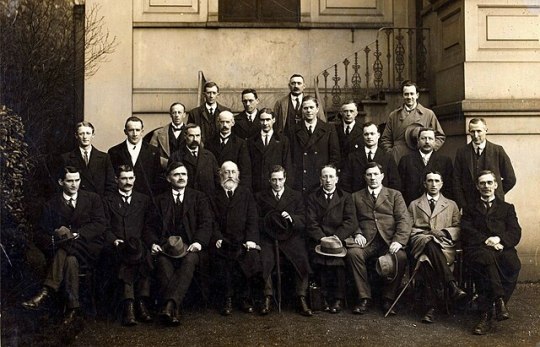
Members of the First Dail
[Image description: A black and white photo of three rows of men. The first row of men are sitting down on chairs, the second and third rows of men are standing. Most men are wearing black suits with white button down shirts and ties. Others are wearing tan or grey jackets. Some men had beards and mustaches, but most are clean shaven. Behind the men is a metal staircase and a white building.]
The constitution was a provisional document and created a ministry of the Dail Eireann. The ministry consisted of a President and five secretaries. First ministers of the Dail were:
Chairperson of the Dail: Cathal Brugha (because DeValera was in jail and Collins and Harry Boland were planning how to break him out)
Minister for Finance: Eoin MacNeill
Minister for Home Affairs: Michael Collins
Minister for Foreign Affairs: Count Plunkett
Minister for National Defense: Richard Mulcahy
The Dail expanded the number of ministers in April. It now included nine ministers within the cabinet and four outside the cabinet as well as a mechanism to create substitute presidents and ministers in the realistic event someone was arrested or killed.
This second ministry members were:
President: DeValera
Secretary for Home Affairs: Arthur Griffith
Secretary for Defense: Cathal Brugha
Secretary for Foreign Affairs: Count Plunkett
Secretary for Labour: Constance Markievicz
Secretary for Industries: Eoin MacNeill
Secretary for Finance: Michael Collins
Secretary for Local Government: W. T. CosgraveAustin Stacks would become minster after his release from jail and then took over as secretary for home affairs after Griffith became deputy president.
Once the Dail was convened, the Irish Volunteers saw themselves as an army of an Irish Republic hence why they named themselves the Irish Republican Army. They were formally renamed the IRA on August 20th, 1919, and took an oath of allegiance to the republic and to serve as a standing army.
On June 18th, 1919, the Dail officially established the Dail courts which were meant to replace the British judiciary. They eventually created several series of courts including a parish-based arbitration courts, district courts, and a supreme court which the people trusted more than the British courts. On June 19th, the Dail approved the First Dail Loan to raise funds they couldn’t raise via taxes. Collins would also create a bond scheme which helped keep the Dail and the IRA financially afloat.
England declared the Dail illegal in September 1919, but it was too little too late to undermine Ireland’s shadow government. DeValera left Ireland to fundraise in the United States, leaving Griffith as his Deputy President. The conduct of the Dail fell to its ministers while the conduct of the war fell to Collins, Mulcahy, Brugha, and the field commanders.
BRIEF Summary of Guerrilla Warfare in Ireland
The IRA would be broken into General Headquarters (GHQ) and local commanders. GHQ was run by Chief of Staff Richard Mulcahy who answered to Cathal Brugha, the Minister of Defense. Mulcahy also worked closely with Michael Collins, Minister of Finance and Intelligence and this amorphous command structure created a lot of tension amongst the three men. While Mulcahy tried to install discipline and standardization from GHQ, he was only partially successful as conditions on the ground often trumped whatever master plan GHQ had cooked up.

Richard Mulcahy
[Image description: A sepia toned photo of a thin white man with a prominent nose. He is wearing the military cap and uniform of the Irish National Army.]
It's estimated that the IRA had 15,000 members but only 3,000 were active at one time. The members were broken into three groups: unreliable, reliable, and active. Unreliable meant they were members in name only, reliable meant they played a supporting role, and active meant they were full-time fighters. It’s believed at least 1/5 of the active members were assistants and clerks. Skilled workers dominated the recruitment while farmers and agricultural workers were a minority. About 88% percent of the IRA members were under thirty and a majority of them were Catholics. The most active units were in Dublin County and Munster County which includes the cities of Clare, Cork, Kerry, Limerick, Tipperary, and Waterford.
The local units were supposed to be organized along the lines of a battalion but it was up to the local commanders, who were originally elected by their men. Initially, GHQ tried to assign two to three brigades to a county, but it would take a while before those brigades solidified. For the first year, the IRA could only muster small units, which actually worked in their favor.
Local commanders adopted the “flying columns” method of attack and GHQ eventually gave it their blessing. Flying columns consisted of a permanent roster of soldiers who worked together in small groups in coordinated attacks. The flying columns performed two kinds of attacks: auxiliary and independent
In an auxiliary attack, the flying column was assigned to a battalion as extra support for a large local operation already taking place. In an independent attack, the flying column itself would strike the enemy and retreat. This type of attack included harassing small military camps and police stations, pillaging enemy stories, interrupting communications, and eventually ambushes. The flying columns would become an elite and coveted unit but its soldiers were always on the run and relied on local support to survive.

Michael Collins
[Image description: A black and white photo of a white man shouting to a large crowd. He is standing outside on a platform, in the middle of a city street. He has short hair and is clean shaven. He is wearing a white shirt and a black suit.]
The IRA would go through two different reorganizations. The first occurred in March 1921. It broke up the brigade structure into small columns, built from experienced men. The brigade staff existed to provide supplier of arms, ammunition, and equipment while battalions provided the men for the columns. During the same reorganization, GHQ broke Ireland up into four different war zones to encourage activity in quieter areas.
In late 1921, the IRA was organized a second time. This time, GHQ created divisions. Division commanders were responsible for large swaths of territory, similar to the war zones created earlier that year. The purpose of the divisional commanders was to increase the likelihood of brigade and battalion coordination, make the IRA feel like it was growing into a real army, but still allowed (and encouraged) independent command, and transplant some of the administrative burden from GHQ to the divisional commanders. This was especially important if something were to happen to GHQ.
You can listen to season 1 to learn about specific battles. For the purpose of this recap, all you really need to know is that the IRA went from singular ambushes lead by ambitious local commanders to coordinated ambushes, assassinations (the most famous being Bloody Sunday carried out by Collins’ personal assassins), prison riots, hunger strikes, and outright assaults on barracks in the rural areas of Ireland. In addition to these military developments, the Dail supported the war effort by retaining the people’s support and maintaining the functionality of the Dail Courts and the Dail Loans.
The British responded by implementing martial law, launching large scale searches and arrests, curfews, roadblocks, and interment on suspicion and by creating the Black and Tans and the Auxiliaries. The Black and Tans arrived in Ireland on March 25th, 1920. They were meant to reinforce the RIC and recruited mostly British veterans. They were called black and tans because of their uniform (dark green which appeared black and khaki. They weren’t special forces, just normal reinforcements which may explain why they were known for their brutality and violence. The auxiliaries were founded in July 1920s as a paramilitary unit of the RICs. It consisted of British officers and were meant to serve as a mobile strike and raiding force. 2,300 men served during the war and they were deployed in the southern and western regions of Ireland – where fighting was the heaviest. They were absolute brutes, known for arson and cruelty.
The British wanted to subdue Ireland by the May 1921 election, so they sent over fifty-one battalions of infantry, however, confusion over the military’s role, the RIC’s role, an inability to coordinate amongst the army, RIC, Black and Tans, and Auxiliaries, and the implementation of martial law hurt British efforts.
The IRA were feeling the pressure. In early 1921, they suffered some of their most drastic defeats contributing to poor morale and disgruntlement with the Dail and GHQ. GHQ was losing control over local forces while also trying to maintain a guerrilla war on a shoestring budget. To make matters worse, DeValera returned from America in December 1920 and spent most of 1921 trying to reorganize the IRA and Dail according to his vision. His arrival exasperated already existing tensions amongst several ministers, including Collins, Mulcahy, and Brugha, and threatened to tear the IRA apart from the inside.
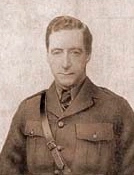
Cathal Brugha
[Image description: A sepia toned photo of a small and thin man in a military uniform and a white button down and stripped tie. He has short hair and is clean shaven. Behind him is a blank white wall.]
Despite all of this, by May 1921, the IRA had reached its peak and the crown forces suffered record losses. From the beginning of 1921 to July, the IRA killed 94 British soldiers and 223 police officers. This was nearly double the totals from the last six months of 1920. This was also when the IRA launched their most ambitious attacks such as their attack on the Shell factory which amounted to 88,000 pounds in damage and their assault on the Dublin Custom House destroying the inland revenue, stamp office, and stationery office records. In addition to these attacks, the IRA increased the number and sophistication of their attacks in what is now Northern Ireland. However, these attacks could be self-defeating as they only enraged the Ulster Volunteers and left the Catholic population at the mercy of angry Unionists. These attacks would convince the British that Ireland was already partitioned (even if Sinn Fein and the IRA refused to acknowledge the fact) and it was in their interest to protect Northern Ireland from IRA incursions. This meant another army and more money that could have been spent elsewhere.
It was clear that neither side could win this conflict through military efforts alone.
References:
The Republic: The Fight for Irish Independence by Charles Townshend, 2014, Penguin Group
Fatal Path: British Government and Irish Revolution 1910-1922by Ronan Fanning, 2013, Faber & Faber
Richard Mulcahy: From the Politics of War to the Politics of Peace, 1913-1924 by Padraig O Caoimh, 2018, Irish Academic Press
A Nation and Not a Rabble: the Irish Revolution 1913-1923by Diarmaid Ferriter, 2015, Profile Books
Eamon DeValera by Ronan Fanning, 2016, Harvard University Press
#Irish War of Independence#Irish History#Michael Collins#Richard Mulcahy#Irish Republican Army#IRA#Eamon Devalera#Cathal Brugha#Constance Markievcz#easter rising#history blog#queer historian#podcast episode#Spotify
11 notes
·
View notes
Photo

On this day, 31 August 1913, police attacked a crowd in Dublin in a drunken rampage that became known as “Bloody Sunday.” It was one of many violent confrontations that took place in the early days of the Dublin Lockout, a bitter industrial dispute that lasted until 1914 and saw two strikers killed and many hundreds wounded. Jim Larkin’s Irish Transport and General Workers Union had attempted to organise the workers on Dublin’s tram network, and the owner of the company, William Murphy, had fired hundreds of workers whom he suspected of sympathising with the union. When the workers struck in protest, the Dublin employers demanded en masse that their workers sign a pledge declaring that they would neither join the ITGWU nor strike with them in solidarity. When workers refused, the employers locked them out, replacing them with scab labour from Britain or elsewhere in Ireland. From the start, the strike was characterised by intense violence between the strikers on one side and the scabs and police on the other. In pitched battles, strikers and their families smashed tram windows and fought with the police, throwing stones and firing slingshots that had been supplied by James Connolly. In response to the escalating violence, the authorities banned a proposed march. But Larkin was not a man easily deterred, and he promised he would appear that dead or alive. The road was overlooked by the Imperial Hotel, which was part-owned by Murphy. Wearing a fake beard, the fiery trade unionist shuffled into a hotel dressed as an elderly man, and once a crowd had gathered on the street below, he cast off his disguise and ran to the window, from where his booming voice exhorted the workers to action and victory. Immediately, around 300 police attacked, beating the crowd, most of whom were uninvolved onlookers. One such onlooker, the MP Handel Booth, later described how the police, “behaved like men possessed… wildly striking with their truncheons at everyone within reach.” https://www.facebook.com/workingclasshistory/photos/a.296224173896073/1797002257151583/?type=3
238 notes
·
View notes
Photo
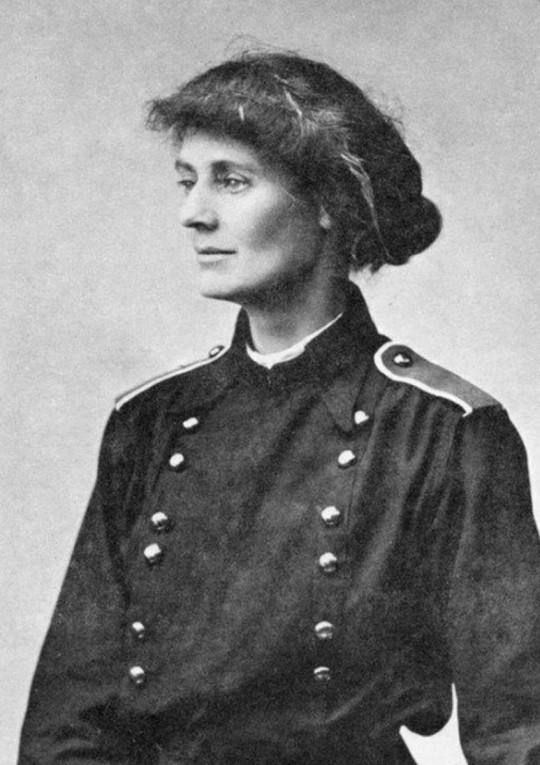
Constance Markievicz - Rebel countess
Constance Markievicz, née Gore-Booth, (1868-1927), was born in London, though her family owned an estate in County Sligo, Ireland. Instead of being a well-to-do lady, Constance wanted to become an artist and left for Paris. There she met a destitute Polish count, Casimir Dunin Markievicz and married him. She gave birth to a daughter in 1901. In 1903, the family settled in Dublin, where Constance helped establish the United Arts Club, but the couple soon became estranged.
By 1907, Constance started to fight for women’s rights. In 1908, she co-founded a scouting organization and trained young people to fight for the nationalist cause. In 1913, she joined the Irish Citizen Army, a group created to protect demonstrators from the police during the 1913 Lockout. Constance also borrowed money and sold her jewelry to feed the starving protesters.
In 1915, she advised women who wanted to be involved in the cause to:
“Dress suitably in short skirts and strong boots, leave your jewels and gold wands in the bank, and buy a revolver. Don’t trust your “feminine charm” and your capacity for getting the soft side of men, but take up your responsibilities and be prepared to go your own way depending for safety on your own courage, your own truth and your own common sense, and not on the problematic chivalry of the men you may meet on the way”.
Constance fought during the 1916 Easter rising, an Irish nationalist and republican rebellion. She was second-in-command of the forces at St. Stephen Green and one of the only two female officers in the Irish Citizen Army. Fourteen other women fought actively among the rebels. Among the insurgents, Constance and Margaret Skinnider were reportedly the best snipers among the insurgents. Constance wore trousers and carried a gun. She wrote about her part in the fight:
“This work was very exciting when the fighting began. I continued round and round the Green, reporting back anything that was wanted, or tackling any sniper that was particularly objectionable”.
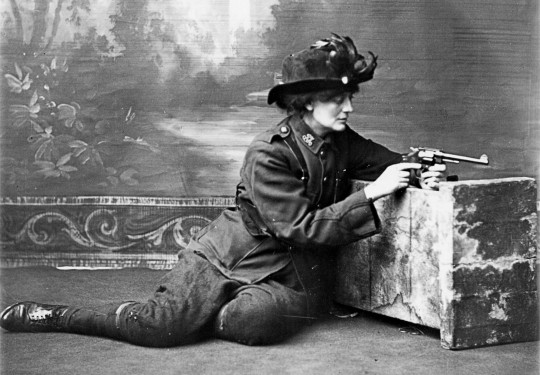
The rebels were forced to surrender after six days. Constance refused at first, but had to give up. She kissed her revolver before handling it to her foes. On may 4, she was tried and sentenced to be executed, but her sentence was commuted to life imprisonment on behalf of her sex. When learning of the verdict she said: “I do wish your lot had the decency to shoot me”.
She was, however, released in 1917 and became the first woman elected to the parliament, in Britain and Ireland and later, as minister of Labour, the second female cabinet minister anywhere in the world.
She fought again during the 1922-1923 Irish civil war. A rifleman who fought by her side gave the following account:
“It made my position in the shelter of the cornice as dangerous a one as you could find. I was due for relief and I wasn’t sorry for that. But when my relief came, who was it but Madame (Constance) (...) I didn’t like the idea of a woman taking over that position. But Madame just waved me to one side with that imperious air she could put when she wanted to have her own way. She slipped into what little shelter there was, carrying with her an automatic Parabellum Pistol (...). I couldn’t rightly say how long she was up there, for I was so tired that I drowsed off to sleep. But when I woke up, the first thing I noticed was something different in the sound of the firing. The steady, continuous rattle of fire that I learned to pick out from the sound of rifle and machine gun fire up and down the street had ceased; the sniper’s post in Henry Street was silent”.
Constance died in 1927, at the age of 59, officially from appendicitis. By then, she had given almost all her fortune to the poor. She received official funerals in Dublin.
Bibliography:
Banerjee Sikata, Muscular Nationalism: Gender, Violence, and Empire in India and Ireland, 1914-2004
“Constance Markievicz”, Women’s museum of Ireland
Cook Bernard, “Constance Markievicz”, in: Cook Bernard (ed.), Women and war: an historical encyclopedia from antiquity to the present
Naughton Lindie, Markievicz: A Most Outrageous Rebel
Sigillito Gina, The Daughters Of Maeve: 50 Irish Women Who Changed World
#Constance Markievicz#20th century#ireland#irish history#women in history#history#warrior women#badass women#women's history#historyblr#military history#photography#war#history edit
395 notes
·
View notes
Photo

#Dublin#Bloody Sunday#Lockout#August 31#1913#Labor#Irish Transport And General Workers' Union#O'Connell Street#Ireland#Police Brutality#James Larkin
3 notes
·
View notes
Text
Book Review
James Plunkett: Strumpet City.★★★★★ Historical Fiction, Irish Literature. Published 1969
Blurb: Set in Dublin during the Lockout of 1913, Strumpet City is a panoramic novel of city life. It embraces a wide range of social milieux, from the miseries of the tenements to the cultivated, bourgeois Bradshaws. It introduces a memorable cast of characters: the main protagonist, Fitz, a model of the hard-working, loyal and abused trade unionist; the isolated, well-meaning and ineffectual Fr O'Connor; the wretched and destitute Rashers Tierney. In the background hovers the enormous shadow of Jim Larkin, Plunkett's real-life hero.
My review: I loved this book. Dublin comes alive in a great HF novel. I enjoy stories that feature a city, treating it like another character. And the people and their desperate plight during the strikes and the lockout were written so well; lots of memorable scenes. It was a hard, bitter time in 1913 Dublin and I think Plunkett wrote a wonderful book. Recommended.

#book review#books#reading#reading list#james plunkett#strumpet city#historical fiction#irish literature
2 notes
·
View notes
Text

JAMES CONNOLLY - IRISH REVOLUTIONARY.
Art by Jim Fitzpatrick.
JAMES CONNOLLY was born in Scotland to Irish parents and was the co-founder of the Irish labour Party in 1912 to unite both Protestant and Catholic workers in the battle for workers’ rights. He led the workers against the notorious lockout of 1913.
Connolly was key to establishing the Irish Citizen Army and led them alongside Pearse’s Volunteers. The wording of the Proclamation of Independence can clearly be seen to be his handwork alongside that of Pearse.
He served as Commandant-General and was badly wounded in the battle for the GPO in Dublin. Tied to a chair he was executed by a British firing squad in 1916. He was buried in quicklime.
1 note
·
View note
Text
bring this back
“There was also the broader context of the ‘Labour Unrest’ that had swept Britain from 1910, an unprecedented period of labour militancy with national strikes by dockers, seamen, miners, railway workers and many others, often involving unskilled, non-unionised workers. In each of the years 1910, 1911 and 1913, there were around 10 million days lost due to stoppages, and in 1912 (with the national miners’ strike) the figure was nearly 41 million. During the four years 1910–1914, somewhere between 25 and 30% of the British workforce went on strike, and more than 85% of those who went on strike were victorious to some degree or another, underlining the way (despite the dramatic reversal of fortune in some individual battles) there was a spectacular growth in the total power of organised labour.”
Ralph Darlington, British labour movement solidarity in the 1913-14 Dublin Lockout
1 note
·
View note
Text
#OTD in 1892 – Birth of insurgent and trade union leader, Rosie Hackett, in Dublin.
Rosie Hackett was a trade unionist, a founder-member of the Irish Women Workers’ Union, and supported strikers during the 1913 Dublin Lockout. She later became a member of the Irish Citizen Army and was involved in the 1916 Easter Rising. Rosie, christened ‘Rosanna’ was born in Dublin on 25 July 1892. At the time of the 1911 Census she lived on Abbey Street with her mother, sister, stepfather,…
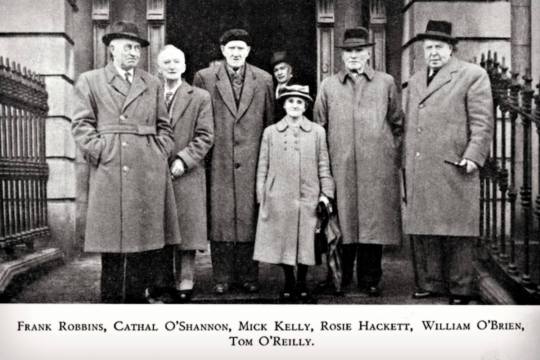
View On WordPress
#1913 Dublin Lockout#1916 Easter Rising#Constance Markievicz#Delia Larkin#Dublin#Insurgent#Ireland#Irish Citizen Army#Irish Transport and General Workers Union#ITGWU#IWWU#Jacobs factory#Jeni Gartland#Liberty Hall#Lisa Connell#Michael Mallon#Rosie Hackett#Rosie Hackett Bridge#Royal College of Surgeons#St Stephen’s Green#trade unionist
6 notes
·
View notes
Link
https://www.youtube.com/watch?v=fMlcJ-qeGxU Dublin Lockout 1913 A TG4 produced documentary on the conflict between the personalities of trade union leader Jim Larking and millionaire employer William Martin Murphy. Credit Dublin Tales
0 notes
Photo

Saint of the Day – 7 June Venerable Matt Talbot OFS (1856 – 1925) (born Matthew Talbot) – Layman, Ascetic, Mystic – known as the “Saint in Overalls” and “the Workers’ Saint”, disciple of Eucharistic Adoration and the Blessed Virgin – Patron of Struggling and Recovering Addicts and Alcoholics and many addiction treatment programs, retreats and centres throughout the world bear his name. His grave is at Our Lady of Lourdes Church, Seán McDermott Street, Dublin.
Ven Matt Talbot lived at an incredibly difficult time. He and his 13 siblings were born into poverty in Dublin shortly after the Irish Potato Famine. One million people died from this largely human-made disaster that saw, even while starvation was rampant, the British government’s siphoning off profit from Irish crops and livestock. Another million people emigrated and alcoholism was rampant among those who stayed behind.
His father beat him, made him change jobs—but nothing could stop Matt’s habit. After work he and his buddies went straight to the pub. Matt spent every penny on drink and once pawned his boots for a pint. Remarkably, his drinking did not prevent his putting in a good day’s work. And he said that when he was intoxicated he occasionally thought about the Blessed Mother and prayed an off-handed Hail Mary. Matt speculated later that she may have had something to do with his conversion.
One day in 1884, when Matt was 28 years old, an incident occurred that changed his entire life. For a week he had stayed away from work, drinking heavily. Saturday found him sober, thirsty and penniless. But confident that his workmates, for whom he had often bought drink, would come to his assistance, he stood with his brother near O’Meara’s pub on the North Strand to meet his colleagues coming from Pembertons. The men passed in twos and threes but none stopped to ask the brothers to have a drink. Matt said later that he was “cut to the heart” by this treatment and went home. Mary Andrews, his sister, reported what happened when Matt came home that day:
My mother said, “You’re home early, Matt, and you’re sober!” He replied, “Yes, mother, I am.” After dinner he remained in the house which was not usual, and finally he remarked to my mother. “I’m going to take the pledge.” She smiled and said, “Go, in God’s name, but don’t take it unless you are going to keep it.” He said, “I’ll go, in God’s name.”
As he was going out mother said, “God give you strength to keep it.” He went to Clonliffe, made his confession, and took the pledge for three months. He had been a couple of years away from the sacraments then. Next morning—Sunday—he went to Holy Communion. On Monday he went to 5 a.m. Mass in Gardiner Street and was at his work as usual at 6 a.m. This he made a regular practice from that time on.

But after his work, to keep away from his companions, he used to walk to a distant church, either St. Joseph’s, Berkeley Road, or St. Peter’s, Phibsboro and remain there until bedtime.
Once or twice—possibly on a Saturday—he went with the men to the public house but he drank only minerals and he usually spent Saturday afternoons away from where he might meet his old companions and generally in a church. He had a bad time of it at first and sometimes said to my mother, that, when the three months were up, he would drink again.
But Matt extended the three months into forty-one years. His new behaviour flabbergasted everyone. Matt supported his sobriety with traditional Catholic disciplines such as prayer, frequent communion, weekly confession, spiritual reading, fasting and charitable works. He also seems to have taken guidance from a wise spiritual director but the person’s name is not known. In 1891, Matt found community support by joining the Franciscan Third Order.
Matt often read the Bible and the lives of saints and he also began reading papal encyclicals on social justice and books on the labour movement. His faith and his concern for the poor led him to action and in 1900 he joined a strike from the Dublin Port & Docks Board to demand a modest raise of sixpence to their daily pay of four and sixpence. When management refused, he was one of four workers who held out from returning to work while the rest slowly gave in to the financial pressure.
He became a loyal member of Ireland’s Transport and General Workers Union. When the Dublin Lockout of 1913 led to sympathy strikes throughout the city, Matt consulted a trusted priest as he discerned joining the strike. The priest encouraged him and Matt joined the strike also came to quote a phrase from a book the priest gave him: “No man has the right to starve a worker into submission.” During this strike, he refused the strike pay given by the union to ease financial hardship, saying that he had not earned it. Later he accepted the pay but shared it among the other strikers. Matt was a vocal supporter of James Larkin, a famous union organizer and major figure in Ireland’s labor movement. One union leader, Stephen McGonagle, described Matt as “a beacon of light to Irish workers.”
Prayer and mortification Matt Talbot mortified himself rigorously. He slept on a plank bed with a piece of timber for a pillow. This left his face numb in later years. He slept in chains which he wore for 14 years before his death, round his leg and on his body.
He prayed each night from 2 to 4 a.m., then dressed and prayed again until it was time to leave for Mass in St. Francis Xavier’s Church. He would arrive at 5am, if not earlier,and would kneel in prayer at the church’s iron railings, waiting for it to open. On entering he would kneel and kiss the ground, then make the Stations of the Cross.
In 1892 Matt took up employment as a bricklayer’s labourer with the firm of T & C Martin, on the North Wall, where he remained until his death. He fasted constantly. His breakfast consisted of cocoa prepared the previous evening by his sister, which he often drank cold. With this he ate some dry bread. For his midday meal he had cocoa to which he would add a pinch of tea and again drank cold. With this he took a slice of bread. His sister would bring him a small evening meal. If she brought fish he would insist that she take it home with her and would make do with bread soaked in the fish juice.
On Sundays he remained in the church for every Mass. Only on returning to his room at about 2 p.m. would he break his fast for the first time since 6.30 p.m. the previous day. The remainder of the day was spent in prayer, reading the Scriptures and the lives of the saints. He gave all his money to neighbours in need and to the missions.
Collapsed and died Matt was on his way to Mass in St. Saviour’s on Trinity Sunday, June 7, 1925, when he collapsed and died on Granby Lane. A paragraph in The Irish Independent of the following day stated, “An elderly man collapsed in Granby Lane yesterday and, on being taken to Jervis Street Hospital, was found to be dead. He was wearing a tweed suit, but there was nothing to indicate who he was.”
He was buried the following Thursday, the feast of Corpus Christi, in Glasnevin Cemetery.
In 1952 Matt Talbot’s remains were exhumed and transferred to a double coffin bearing the inscription, ‘The Servant of God, Matthew Talbot.’ The coffin was placed in a vault in the central circle of the cemetery to which pilgrims began to flock from all over the world.
In 1972 Matt Talbot’s remains were removed to the Church of Our Lady of Lourdes in Sean McDermott Street. The tomb has a glass panel through which the coffin may be seen.
He was declared Venerable by Blessed Pope Paul VI in 1975.


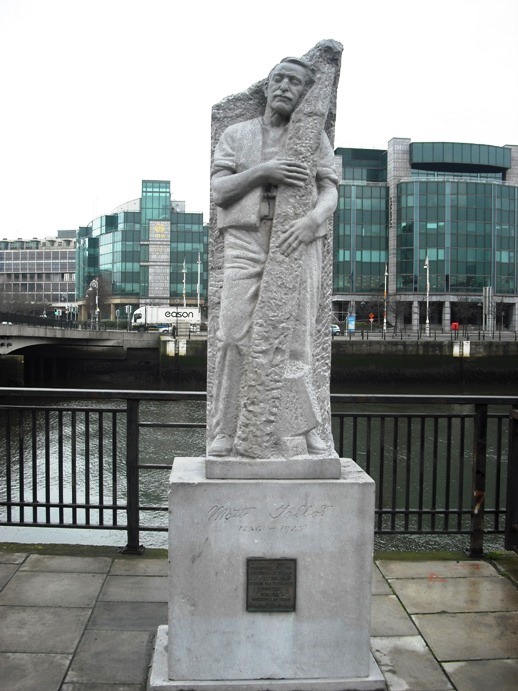
PRAYER for the CANONISATION OF VENERABLE MATT TALBOT
Lord, in your servant, Matt Talbot you have given us a wonderful example of triumph over addiction, of devotion to duty and of lifelong reverence of the Holy Sacrament. May his life of prayer and penance give us courage to take up our crosses and follow in the footsteps of Our Lord and Saviour, Jesus Christ. Father, if it be Your will that Your beloved servant should be glorified by your Church, make known by Your heavenly favours the power he enjoys in your sight. We ask this through Jesus Christ Our Lord, in union with the Holy Spirit, one God forever and ever, Amen.
Anyone who receives a favour through the intercession of Matt Talbot is requested to write to Fr John Flaherty, Vice-Postulator of the Cause, Our Lady 83 Marlborough Street, Dublin 1.


40 notes
·
View notes
Photo

Rosanna "Rosie" Hackett (25 July 1893 – 4 May 1976) was an Irish insurgent and trade union leader. She was a founder-member of the Irish Women Workers' Union, and supported strikers during the 1913 Dublin Lockout. She later became a member of the Irish Citizen Army and was involved in the 1916 Easter Rising. In the 1970s, the labour movement awarded Hackett a gold medal for decades of service, and in 2014 a Dublin city bridge was named in her memory. https://www.google.com/amp/s/www.adccollege.eu/adcblog/2018/1/9/the-curious-story-of-rosie-hackett%3fformat=amp https://www.instagram.com/p/Buofn9dAheS/?utm_source=ig_tumblr_share&igshid=4qjyyu7p0s70
0 notes
Photo

On this day, 31 August 1913, police attacked a crowd in Dublin in a drunken rampage that became known as “Bloody Sunday.” It was one of many violent confrontations that took place in the early days of the Dublin Lockout, a bitter industrial dispute that lasted until 1914 and saw two strikers killed and many hundreds wounded. Jim Larkin’s Irish Transport and General Workers Union had attempted to organise the workers on Dublin’s tram network, and the owner of the company, William Murphy, had fired hundreds of workers whom he suspected of sympathising with the union. When the workers struck in protest, the Dublin employers demanded en masse that their workers sign a pledge declaring that they would neither join the ITGWU nor strike with them in solidarity. When workers refused, the employers locked them out, replacing them with scab labour from Britain or elsewhere in Ireland. From the start, the strike was characterised by intense violence between the strikers on one side and the scabs and police on the other. In pitched battles, strikers and their families smashed tram windows and fought with the police, throwing stones and firing slingshots that had been supplied by James Connolly. In response to the escalating violence, the authorities banned a proposed march. But Larkin was not a man easily deterred, and he promised he would appear that dead or alive. The road was overlooked by the Imperial Hotel, which was part-owned by Murphy. Wearing a fake beard, the fiery trade unionist shuffled into a hotel dressed as an elderly man, and once a crowd had gathered on the street below, he cast off his disguise and ran to the window, from where his booming voice exhorted the workers to action and victory. Immediately, around 300 police attacked, beating the crowd, most of whom were uninvolved onlookers. One such onlooker, the MP Handel Booth, later described how the police, “behaved like men possessed… wildly striking with their truncheons at everyone within reach.” https://www.facebook.com/workingclasshistory/photos/a.296224173896073/1516268428558302/?type=3
202 notes
·
View notes
Text
It's Roland Mouret for Dublin Day Two!
New Post has been published on http://harryandmeghan.xyz/its-roland-mouret-for-dublin-day-two/
It's Roland Mouret for Dublin Day Two!

The Duke and Duchess of Sussex began the second day of their official visit to Dublin with a visit to the official residence of the President, Aras an Uachtarain in the city’s Phoenix Park.

The couple were warmly welcomed by President Michael D Higgins and his wife Sabina.

Meghan was quite taken with The Higgins’ Bernese Mountain dogs, Brod and Sioda.

We know Meghan has already charmed the Queen’s Corgis, she clearly has a way with animals and was a hit with the adorable pair this morning.

More from the Mail Online:
‘The President has had Bernese mountain dogs for over 19 years and took in Sioda, a Bernese Mountain dog, who was left homeless when his previous owners emigrated in search of work in 2012.
He has since given a home to another Bernese Mountain dog named Bród, who, along with Sioda, accompanies the President every morning on his walk through the grounds of Áras an Uachtaráin.
A versatile working dog from Switzerland, Bermese mountain dogs were bred to herd cattle and pull carts and can weigh up to 120 lbs and grow up to 70 cm.’
In case you haven’t heard, England will compete against Croatia in the World Cup semi-final later this evening. The football match is on everyone’s minds (at least in my house :)). The royals are also eagerly awaiting kick off tonight. Harry was asked by a reporter if football was coming home. “Most definitely,” he said laughing. It’s understood Harry and Meghan will be back in London in time for most of it. Indeed, Prince William just sent this message to the team “A new generation is enjoying the magic of this World Cup run. The whole country is right behind you tonight. Come on England – it’s coming home!”

Meghan and Sabina Higgins chatting.

The couple were given a tour of the Aras.

They heard about the history of the residence.

Harry and Meghan signed the visitors book.

The foursome posed for official photos.

A beautiful photo of the Sussexes.

The Mirror reports “The four VIPs stood on the steps, chatting and stroking the dogs before walking across to view an oak tree planted in 2011 by the Queen before moving onto the Peace Bell. With Harry at the end nearest the bell, all four stood in a line holding a sash and then pulling it to ring the bell once for peace. Unveiled in 2008 by then President, Mary McAleese, the Peace Bell was designed to mark the 10th anniversary of the Belfast Agreement. They also viewed a sculpture entitled “The Plough and The Stars”, which the president and his wife unveiled on Labour Day 2018, “The Plough and The Stars” by John Behan commemorates the 1913 Lockout – a founding moment for workers and trade unions in Ireland”

Aras an Uachtaráin, formerly the Viceregal Lodge, is the official residence and principal workplace of the President of Ireland. It is located off Chesterfield Avenue in the Phoenix Park in Dublin. The building, which has ninety-five rooms, was designed by Nathaniel Clements and completed in 1751.

The office of President of Ireland was created in 1937. In 1938, the first President, Douglas Hyde lived there temporarily while plans were made to build a new presidential palace on the grounds. The outbreak of World War II saved the building, which had been renamed Áras an Uachtaráin (meaning house or residence of the president in Irish), from ruin, as plans for its demolition and the design of a new residence were put on hold. By 1945 it had become too closely identified with the presidency of Ireland to be demolished, though its poor condition meant that extensive rebuilding of parts of the building were necessary, notably the kitchens, servants’ quarters and chapel. Since then, further restoration work has been carried out from time to time.

President Higgins saying his goodbyes to the Duchess.

A video from the visit.
[embedded content]
The Duchess wore a bespoke taupe Roland Mouret dress with a boat neck and long sleeves for the morning. The skirt of the dress is remarkably similar to the designers Barwick dress Meghan wore the night before the wedding.



And Meghan accessorised with her Birks Snowflake Snowstorm Diamond Earrings. The $12,000 pair are described as “Inspired by the icy beauty of Canadian winters, these 2.15ct diamond earrings are crafted in 18kt white gold.”

The Duke and Duchess have a busy afternoon of engagements coming up.
Source: http://madaboutmeghan.blogspot.com/2018/07/first-look-its-roland-mouret-for-dublin.html
0 notes
Video
LOCKOUT MEMORIAL [LOCATED IN DUN LAOGHAIRE]-160174 by William Murphy Via Flickr: The Dublin lock-out was a major industrial dispute between about 20,000 workers and up to 300 employers which took place in Dublin. The dispute lasted from 26 August 1913 to 18 January 1914, and is often considered to be the most severe and significant industrial dispute in Irish history. Central to the dispute was the workers' right to unionise. To give some context - Irish workers lived in terrible conditions in tenements. For example, 835 people lived in 15 houses in Henrietta Street's Georgian tenements. At number 10, Henrietta Street, the Irish Sisters of Charity ran a laundry inhabited by more than 50 single women. The lock-out eventually concluded in early 1914, when the TUC in Britain rejected Larkin and Connolly's request for a sympathetic strike. Most workers, many of whom were on the brink of starvation, went back to work and signed pledges not to join the ITGWU. The ITGWU was badly damaged by its defeat in the Lockout, and was further hit by the departure of Larkin to the United States in 1914 and the execution of Connolly, one of the leaders of the Easter Rising in 1916. The union was rebuilt by William O'Brien and Thomas Johnson. By 1919, its membership surpassed that of 1913. Many of the blacklisted workers joined the British Army, having no other source of pay to support their families, and found themselves in the trenches of World War I within the year. Although the actions of the ITGWU and the smaller UBLU had been unsuccessful in achieving substantially better pay and conditions for workers, they marked a watershed in Irish labour history. The principle of union action and workers' solidarity had been firmly established. No future employer would ever try to "break" a union in the way that Murphy [Ireland's most prominent capitalist] attempted to with the ITGWU. The lock-out had damaged commercial businesses in Dublin, with many forced to declare bankruptcy.
#memorial#1913#dublin lockout#dun laoghaire#Henrietta Street#TUC#ITGWU#Easter Rising in 1916#Irish Sisters of Charity#william murphy#infomatique#fotonique#ireland#history
0 notes
![LOCKOUT MEMORIAL [LOCATED IN DUN LAOGHAIRE]-160174](https://live.staticflickr.com/65535/49527928661_3802f2ed43_b.jpg)
